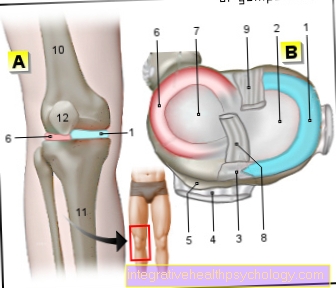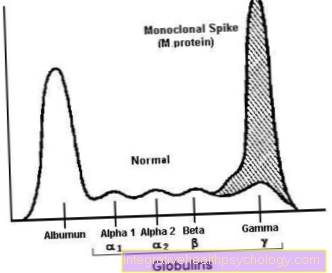pH in humans
definition
The pH value indicates how acidic or basic a solution is. Usually you use the Brønsted acid-base definition: When particles are protons (H + ions) these are called proton acceptors, or bases; if particles can give off protons, then one speaks of proton donors or acids. Accordingly, the pH value depends on which substances are in a solution and how they react with one another.
As a rule, pH values fluctuate between 0 and 14. At a pH below 7 a solution is acidic, at a pH above 7 one speaks of a basic solution. A solution with pH 7, e.g. Water, is neutral.

The Stomach acid for example has one pH 1.0 (= strongly sour), however, has Juice of the pancreas one pH of approx. 8 (= basic). The pH value is strongly dependent on the composition of a solution: if the amount of acid increases, the solution becomes more acidic, the pH decreases and vice versa. Because of this, the pH of the Blood or des Stomach for example, change depending on location and metabolism.
It is also important that the pH value is also one Influence on the activity of enzymes Has. While most enzymes work at a neutral pH, some enzymes, such as the digestive enzymes in the stomach, can only function at a very low (i.e. acidic) pH.
The pH can also be a Protective function take against bacteria or pathogens.
pH in the blood
The pH value of the blood is important for many cell functions and should have a constant value between 7.35 and 7.45 in order to maintain good body function. To keep the pH constant, there are various buffer systems in the blood, the most effective of which is the carbonic acid buffer. Proteins, phosphate and hemoglobin also buffer the pH of the blood. But what is a buffer?
Most solutions become acidic when acid is added or basic when bases are added. Buffer solutions, on the other hand, can compensate for the addition of an acid or a base in a certain range and can then keep the pH constant. These buffer systems are extremely important because they enable the body to produce acids (Waste products) without affecting the blood pH value.
If the buffer systems are insufficient and the pH value falls below 7.35, then acidosis (= over-acidification) is present. If the pH value exceeds 7.45, then one speaks of an alkalosis. Acidosis and alkalosis can have serious consequences for those affected, such as shortness of breath and cardiac arrest. To prevent this, the pH value of the blood is regulated by breathing and kidney function or kept constant by the buffer systems.
More detailed information on this topic is available at: pH in the blood
If more protons fall out due to the metabolism, then these can be compensated by increasing the exhalation of CO2 or by reducing the excretion of bicarbonate by the kidneys. On the other hand, however, the acid-base balance of the blood can be unbalanced by impaired kidney function or breathing disorders. In this case one differentiates between the respiratory alkalosis / acidosis of the metabolic alkalosis / acidosis.
A respiratory alkalosis occurs when too much CO2 is exhaled, such as when hyperventilating. The respiratory acidosis on the other hand, when not enough CO2 is exhaled, e.g. by breathing less. A metabolic alkalosis arises either when too many bases are produced or when acids are lost (e.g. when vomiting stomach acid is lost). The metabolic acidosis occurs mainly in kidney insufficiency (too little acid excretion) or in diabetes mellitus in the form of a so-called. Ketoacidosis. If left untreated, ketoacidosis can lead to coma and possibly death. To a certain extent, a metabolic derailment can be compensated for by respiration and vice versa.
urine pH
The pH value of the urine can reach values between approx. 5 (slightly acidic) and 8 (slightly basic) depending on your physical condition and the time of day, but the pH value of the urine is usually around 6. In addition to the exhalation of carbon dioxide the body can also get rid of excess protons via the urine. Protons are found in the urine in the form of ammonium (NH4 +) and phosphate ions.
Depending on the amount of free protons in the terminal urine, the urine can have a pH value of up to 4.5.
One of the functions of the kidneys in the framework of the acid-base balance is the re-absorption of bicarbonate from the urine. Depending on how the blood pH is (acidic or basic), the absorption of bicarbonate from the urine can be increased or decreased and thus change or buffer the blood pH.
The pH value in the urine is used diagnostically to determine kidney function. In the case of diseases such as kidney stones or urinary tract infections, the pH changes. For example, some kidney stones tend to develop when the pH value is very low or very high.In the case of urinary tract infections due to bacterial contamination, the pH of the urine can become highly alkaline.
Read more on this topic at: pH test strips, urine pH
How do I use the measuring strip / test strip correctly?
The pH value should ideally be measured on three consecutive days before and after each meal in order to avoid a mere snapshot of the pH value. In this way you can create and compare a daily profile. If you want to measure the pH in the urine, the test strip must be held directly under the urine stream for a few seconds. The pH measurement does not work correctly with left standing urine because the urine spontaneously becomes alkaline at room temperature. The change in color of the pH test strip is then compared with the color scale on the package insert and the corresponding pH value read off.
pH of the skin
One of the most important functions of the skin is Protection of the organism from bacteria and pollutants. To ensure this is the optimal skin pH just below 5 so in the acidic range. This slightly acidic environment prevents most of them from growing pathogenic bacteria and promotes the development of Skin flora. Bacteria that would harm the organism cannot develop.
In addition, some skin surface enzymes work better at acidic pH. These enzymes mainly serve to maintain the skin barrier, which also has a protective function. Since the acidic pH value of the skin serves to protect the body in many ways, it is also "Acid mantle" called. This protective layer on the skin depends on gender and age and is influenced by the use of cosmetics and skin cleansers. Too frequent washing and some cosmetics, medication or chemicals can, in addition to damaging the protective barrier, also cause the skin to become alkaline. If the pH value becomes too alkaline, the protective acid mantle no longer works and the skin becomes particularly prone to dehydration and infections.
scalp pH
The pH of the scalp in healthy people is around 5.5 on the pH scale. If the pH of the scalp and hair falls below 6.0, this causes the cuticle layers to contract (outermost surface of the epidermis, skin). If the pH rises significantly above 7 to basic values, the cuticle of the scalp becomes porous and loosens.
pH value of sweat
Sweat arises in various sweat glands and consists in large quantities of water, but also of table salt, lactic acid, uric acids and many other substances. There is "eccrine sweat" that is formed by the whole body and is very thin. In addition, the "apocrine sweat" is milky-cloudy, thick and only occurs in the armpits, nipples, genital and anal areas. Eccrine sweat glands also occur in these regions, so that sweat mixes here. Eccrine sweat has a pH value of 4.5 and is therefore more acidic. In people who sweat profusely, the pH of the sweat shifts up to 6.0. Apocrine sweat has an average pH between 6.2 to 6.9.
pH in the amniotic fluid
Amniotic fluid is mainly produced in the amniotic cavity and surrounds the fetus throughout pregnancy. The pH value of the amniotic fluid is usually 7. In contrast to acidic urine, amniotic fluid is more neutral to alkaline. During pregnancy, this can be used to distinguish a rupture of the bladder from a temporary incontinence. If you suspect a rupture of your bladder due to sudden wet underpants or uncontrolled urination, a pH strip can be placed on the wet surface. If the discoloration of the strip indicates a pH above 7, it is an alkaline liquid and therefore most likely a cracked bubble; if the discoloration indicates a pH below 7, it is an acidic liquid and therefore a rupture of the bubbles can be excluded.
Read more on this topic at: pH test strips
vaginal pH
The pH value of the vagina corresponds to the secretion that is continuously formed by the vaginal mucous membranes. The special thing about the vagina is that the pH value of the vaginal secretion can change. It is subject to fluctuations in the woman's hormonal balance. For a menstruating woman, the pH is ideally between 3.8 and 4.4 on the pH scale. The acidic pH value in the vagina is due to the lactobacilli present there. These germs occur naturally in the vagina and produce lactic acid. The lactic acid and the resulting acidic environment provide the vagina with natural protection against infections and irritations. If the pH value becomes significantly more basic, this weakens the defense mechanism and bacteria can spread better. An increased pH in the vagina makes it easy for vaginal thrush (Candida albicans) to grow there.
Read more about the topic here: Vaginal fungus
Sperm pH
The sperm has a pH of 7.2 to 7.8. The seminal fluid is more basic than acidic. The vagina has an acidic pH of 3.8 to 4.4 on the pH scale. Sperm need a basic environment in order to be able to move in the vagina.
Salivary pH
The pH value of saliva with neutral values around 7 is ideal to fulfill its functions. These include, for example, the digestion of carbohydrates on the way to the stomach and the remineralization of tooth enamel after diet-related acid attacks. After stimulation through ingestion of food, the pH value in the saliva rises up to 7.2. At rest, between meals, the pH can drop to values between 6.5 and 6.9. A normal pH is around 7 to 7.1. The pH value is also influenced by the bacterial colonization of the mouth.
pH in the stomach
The gastric juice is in the stomach and contains large amounts of gastric acid. Stomach acid is particularly rich in hydrochloric acid. The pH value in the stomach is between 1.0 and 1.5, i.e. in a strongly acidic environment. During food intake, the pH value rises to values between 2 and 4. Due to the high content of stomach acid, the pH value in the stomach generally remains acidic. Increased acid build-up in the stomach can cause unpleasant symptoms such as reflux / heartburn.
More information can be found here: pH in the stomach
How do the measuring strips / test strips for the pH value work
The acid value of any solution can be measured with test strips, the pH indicator paper. The pH test strips can be bought over the counter in drugstores and pharmacies. The liquid to be examined is poured over a test strip and the color discoloration of the test strip is observed. There is a characteristic color tone for each pH value on the pH scale, so that the color on the test strip can be compared with the color sample in the package insert and the pH value can be read off.
What is a neutral pH value in humans?
The pH value is a measure of the degree of acidic or basic reaction of a liquid. More precisely, it is the concentration of the hydrogen ions contained in the respective solution.
The human body consists of more than 2/3 of water and of constant metabolic processes in an aqueous environment. Different human organs have different pH values. The fluid in the pancreas and intestines have a basic pH of around 8.0. The blood is also clearly basic with a pH value between 7.35 and 7.45. The muscles and cells of the organs have an average pH of 6.9 and are slightly acidic. Our gastric juice is particularly acidic with an empty reading of 1 to 1.5. Neutral pH values are 7 on the pH scale. An example of neutral pH values in humans is saliva, which is ideally 7 or slightly basic at 7.1.





























